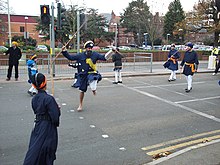Shastar Vidiya

Gatka demonstration in Bedford, England (2007)
|
|
| Focus | Weaponry |
|---|---|
| Country of origin |
|
| Famous practitioners |
Guru Hargobind Emperor Akbar Guru Gobind Singh Bhai Daya Singh Sahibzada Ajit Singh Sahibzada Jujhar Singh Kapur Singh Mai Bhago Baba Deep Singh Phula Singh |
| Olympic sport | No |
Gatka (Punjabi: ਗਤਕਾ gatkā, Urdu:گٹکا) is a traditional South Asian form of combat-training in which wooden sticks are used to simulate swords in sparring matches. In modern usage, it commonly refers to the northwestern Indian martial arts, which should more properly be called shastara vidiyā (ਸ਼ਸਤਰ ਵਿਦਿਆ, from Sanskrit sastra-vidya or "science of weapons"). In English, the terms gatka and shastar vidya are very often used specifically in relation to Panjabi-Sikhs. In actuality, the art is not unique to any particular ethno-cultural group or religion but has been the traditional form of combat throughout north India and Pakistan for centuries. Attacks and counterattacks vary from one community to another but the basic techniques are the same. This article will primarily use the extended definition of gatka, making it synonymous with shastara-vidiya.
Gatka can be practiced either as a sport (khel) or ritual (rasmi). The sport form is played by two opponents wielding wooden staves called gatka. These sticks may be paired with a shield. Points are scored for making contact with the stick. The other weapons are not used for full-contact sparring, but their techniques are taught through forms training. The ritual form is purely for demonstration and is performed to music during occasions such as weddings, or as part of a theatrical performance like the chhau dance. A practitioner of gatka is called a gatkabaj while a teacher is addressed as Guru or Gurudev.
Gatka originated in what is now north India and neighbouring Pakistan where the regional system of fighting is today most commonly termed shastara-vidiya, originally a classical Sanskrit word for armed combat. Its creation is attributed to the god Shiva and his devotees. The oldest manual on the northern Indian fighting system was said to have been the Shiva Dhanurveda, at present no longer extant. The sage Vasistha is said to have based his own work, the Dhanuveda Samhita, on the aforementioned manual. Early Shaivite sages and Kapalika are credited as progenitors and disseminators of the art of combat, even the most peaceful of whom are recorded as being fierce when confronted by enemies.
...
Wikipedia
